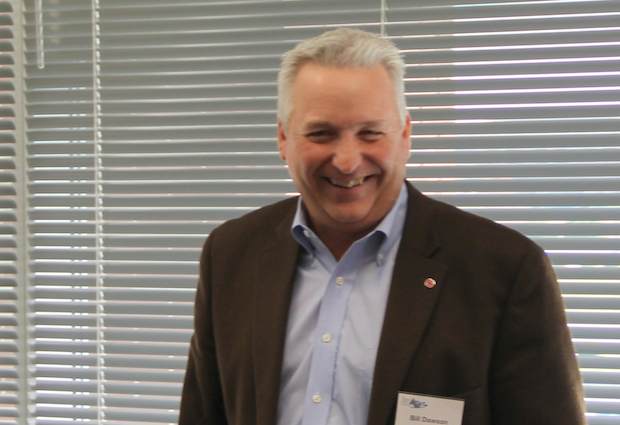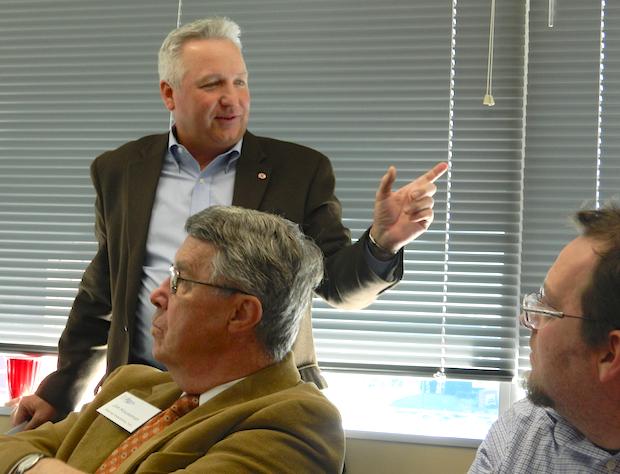
Bill Dawson, founder and CEO of NexTech, talks about innovation at a networking lunch at ACerS headquarters on Thursday. Credit: ACerS.
Yesterday ACerS welcomed 29 visitors from the Central Ohio region to its Westerville headquarters for a networking lunch and presentation on “Commercializing Technology” by Bill Dawson, founder and CEO of NexTech Materials in Lewis Center, Ohio. Most of the guests work in the industrial ceramics sector for companies like Saint-Gobain Proppants, Zircoa, Allied Minerals, Harrop Industries, and others. A few represented academic institutions such as Ohio State University and Case Western Reserve University.
Dawson, who with Scott Swartz founded NexTech in 1994, talked about the importance of innovation at a company like NexTech. The company is still independent and privately owned by the two founders.
From the beginning, NexTech’s vision has been to provide materials solutions for the energy and environmental challenges. One of the first technologies the company addressed was solid oxide fuel cells, but about 13 years ago they realized that significant commercialization of SOFC technology was still a long way off. Dawson noted that, without the support of investors or other external funding sources, they had to come up with products to sell, which led to the evolution of four NexTech brands to serve fuel cell, battery, sensor, and emerging markets.
“It’s hard to invent, but it’s even harder to take products to market,” Dawson says. In this regard, staying focused on what you do best is key. NexTech identifies its core technical competencies as advanced ceramics, electrochemistry, and nanomaterials, and the intersections of these competencies (imagine a Venn diagram) represent product opportunities with identified markets such as sensors, catalysts, electrocatalysts, and SOFCs.
Dawson identified four innovation drivers: large, government-funded projects; product development in collaboration with defined customers; expansion of existing product lines; and cost reduction. Focusing on the second driver—product development—he shared two examples of innovation at NexTech using a typical stage-gate approach to push ideas into the innovation pipeline.
The first example is protective coating for SOFC interconnects. The SOFC market is finally poised for growth in stationary power generation applications at hospitals, grocery stores, office buildings, and data centers. Growth for mobile applications is expected as well.
The design lifespan of an SOFC running at 800˚C is 80,000 hours. For a long time, the tradeoff between cost of interconnect stainless steels and corrosion has been a problem. Chromium can exit cost-effective ferritic stainless steels and poison the lanthanum strontium manganite electrode. NexTech developed a manganese cobalt oxide coating that effectively isolates the steel from the electrode (see our earlier CTT report on successful accelerated testing of the coating). The challenge was how to commercialize the technology. The company wanted to maintain control of the intellectual property, but building plants close to steel suppliers was not feasible. In this case, NexTech chose to license the technology and provide the coating materials, keeping open the option for further innovation and possibly manufacturing.
The other example Dawson described was development of a hydrogen sensor. Originally the technology was developed for the SOFC market, but “the need had passed by the time the technology was successful,” according to Dawson. Searching for other applications, the company worked with Case Western Reserve University to adapt the the now-successful sensor for new applications. NexTech now markets the sensor to monitor nuclear power plants, utility transformers, and lithium-ion batteries. The commercialization model in this case is to manufacture the active ingredients, then assemble and calibrate devices using parts bought from vendors.
Dawson emphasized the importance of working closely with customers, not straying from core technical competencies, and having a disciplined, robust stage-gate process for R&D.
One attendee asked how the company found applications for the hydrogen sensor technology, which had, after all, been developed for an SOFC market that no longer was interested. The company went to a few conferences to discover what sorts of problems were out there for which they already had a solution, which is how the battery alarm system came about. Anyone in a similar situation might consider attending these ACerS conferences in 2014.
Electronic Materials and Applications
January 22–24
Orlando, Fla.
Basic science, engineering and applications of electroceramic materials for electronic, magnetic, dielectric and optical components, devices and systems.
International Conference on Advanced Ceramics and Composites
January 26–31
Daytona Beach, Fla.
Newest research and product developments in advanced ceramics, armor ceramics, solid oxide fuel cells, ceramic coatings, bioceramics, advanced structural and functional ceramics, composites, and emerging technologies.
Materials Challenges in Alternative and Renewable Energy
February 16–20
Clearwater, Fla.
Materials challenges and innovations in areas of hydrogen, solar energy, solar power and concentrators, battery and energy storage, nanocomposites and nanowires, nuclear, critical resources, and other energy technologies.
April 7–9
Baltimore, Md.
A focused business and strategy summit for C-level executives, senior managers, and rising engineers and managers engaged in ceramic materials manufacturing.

